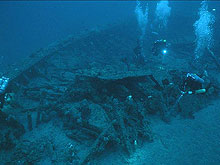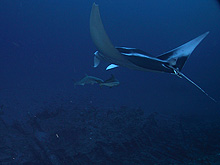Artifacts from the USS Monitor Collection:
Monitor National Marine Sanctuary
This collection showcases artifacts collected from the Civil War ironclad USS Monitor. These artifacts illustrate the technological advancements of the Monitor and what life was like for the crew on board this historic vessel. The artifacts also remind us of the careful and important work required to recover, preserve, and protect our nation's cultural resources.
Introduction

The wreck of the famous Civil War ship, the USS Monitor, lies 230 feet below the surface of the ocean, off the coast of North Carolina, in the Monitor National Marine Sanctuary. Click image for larger view.
Built in 1862, the USS Monitor was steam powered and completely armored. Engineering spaces, crew and officer quarters, and the galley were all located below the waterline. The famous 21 1/2-foot diameter, revolving gun turret was the first of its kind. This Civil War ship was a radical departure from traditional warship design of the time. Her battle with the CSS Virginia in Hampton Roads on March 8-9, 1862, was the first clash of ironclads and the Monitor's only experience in combat.
The CSS Virginia was a Confederate ironclad built from the burned hull of the USS Merrimack. The Monitor was ordered to Hampton Roads in early March 1862 to defend the Union against the powerful Virginia. The two ships clashed on the morning of March 9, bombarding each other for over four hours with no substantial damage to either vessel. Although there was no clear victor in the battle, the Monitor succeeded in preventing further destruction to the Union blockade.
On December 31, 1862, while under tow by the Rhode Island en route to Beaufort, North Carolina, the Monitor sank in a storm off Cape Hatteras, North Carolina, in an area nicknamed the "graveyard of the Atlantic."
The Monitor National Marine Sanctuary was designated on January 30, 1975, to protect and preserve the remains of what has been called the most significant ship in American history.
About this Collection
This is a collection of ten artifacts recovered from the USS Monitor. These artifacts illustrate the technological advancements of the Monitor and what life was like for the crew on board this historic vessel. In addition to capturing a piece of history, the highlighted artifacts remind us of the careful and important work required to recover, preserve, and protect our nation's cultural resources.
Expeditions to the Monitor have yielded a large variety of artifacts that include huge iron components, delicate glass bottles, lumps of coal, wood paneling, a leather book cover, and even walnut halves. In 2001 alone, more than 250 artifacts arrived at The Mariners' Museum to be conserved and prepared for exhibition at The Monitor Center in Newport News, Virginia. Some of these items are featured in this smaller, online collection, while the complete collection is available at The Mariners' Museum.
You can browse through the artifacts in the collection by clicking on the links to the right or click here to view the items in the USS Monitor Collection.
About the Monitor Sanctuary and the Larger Collection

This map shows the location of the Monitor National Marine Sanctuary, 16 miles off the coast of North Carolina, in an area once known as the "graveyard of the Atlantic" because so many ships perished along these shores. Click image for larger view.
The Monitor Sanctuary is part of the National Marine Sanctuary Program, which protects a system of 14 underwater parks, encompassing more than 150,000 square miles of marine and Great Lakes waters. Designated as a sanctuary in 1975, the Monitor National Marine Sanctuary was the nation's first marine protected area.
Numerous research and recovery expeditions coordinated by NOAA and the U.S. Navy have occurred since the sanctuary was created. Divers have successfully recovered many artifacts from the shipwreck, including the engine, propeller, anchor, turret, cannons, and many small objects.
Because of its location 16 miles off the coast of Cape Hatteras, North Carolina, in 230 feet of water, the majority of the public cannot visit the Monitor National Marine Sanctuary. They can, however, view many of the recovered artifacts on display at The Mariners' Museum in Newport News, Virginia.

A manta ray swims above the shipwreck in the Monitor National Marine Sanctuary. Click image for larger view.
The Mariners' Museum was designated the principal museum for the Monitor National Marine Sanctuary in 1987. The museum curates the Monitor collection, which includes all artifacts recovered from the site, as well as a large collection of historical materials and research data generated by expeditions to the site.
The collection contains documents and other materials donated by various agencies and individuals that have been associated with the Monitor National Marine Sanctuary. This collection was compiled by NOAA, remains a federal collection, and thus is available for research by students, the public, and the professional community. Anyone wishing to carry out research can contact the Monitor National Marine Sanctuary to arrange an appointment.
In March 2007, the Museum will open the USS Monitor Center, a 63,000 square-foot exhibit that will showcase the history, discovery, and recovery of the Monitor. The Center will also allow visitors to view the current conservation efforts underway to preserve the turret, cannons, and engine.
Contributed by Krista Trono and Jeff Johnston, NOAA's National Ocean Service










